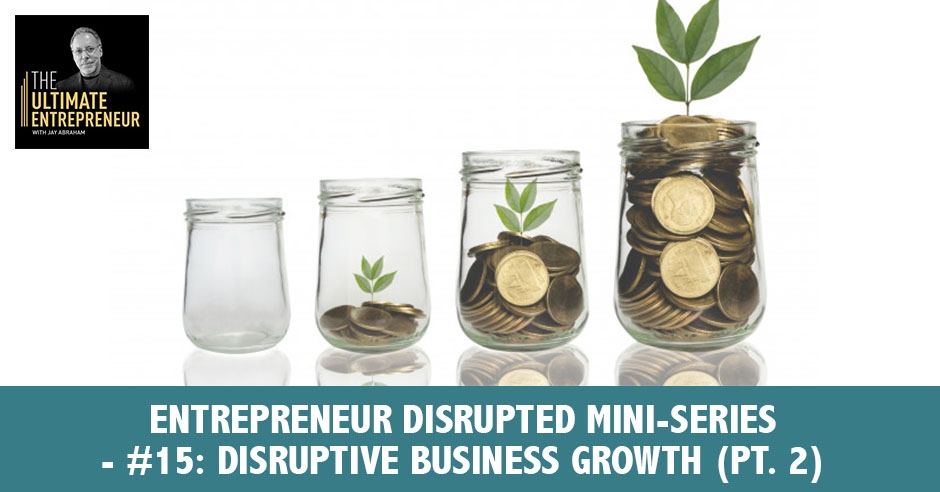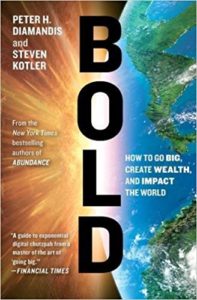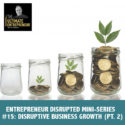
The “Get rich quick, travel the world, and only work a couple hours a week” perspective is oftentimes how you sell, but not how you build. It’s about building a very high quality superior product, and then selling the crap out of it, VERSUS the quick way out – which is building something that will at least hold together long enough to get it out the door, and then selling the crap out of it. Sure, you might make more in the short term, but you won’t build an enduring brand and you won’t build loyal fans, because you’re selling crap… and they can tell.
In #15 of Entrepreneur Disrupted, Jay Abraham and Dave Asprey pick up where they left off on the fundamentals and nuances of disruptive business growth. Learn how to build your business on a foundation of integrity and quality by crafting a product that actually does as advertised; how to master systems-based thinking and putting together a structure; and how to tell your story not just intelligently, but also in a way that’s absolutely enticing!
Listen to the podcast here:
Entrepreneur Disrupted Mini-Series – #15: Disruptive Business Growth (Pt. 2)
I present to you the second installment of our segment on disruptive business growth, where we continue to add more distinguished insights to those we had in our last episode. These range from having a product that actually does what it says it does, building a foundation on integrity and quality, having the right people to support you along the way, especially when mastering systems-based thinking and putting together a structure, which we’ll cover extensively. Telling your story, not intellectually or intelligently, but making it absolutely enticing, animated and graspable, and my own advanced three methods for growing any business into the stratosphere. I hope you do what is essential to your own business aspirations and take meaningful action from the wisdom and advice and illustrations we’ve distilled in this episode.
We’re going to continue part two of growing a business. What do you do to grow a business? This is Jay and me sharing a lot of experience and a lot of knowledge with you so you can take this and do what you want with it. Here’s what I think about growing a company. The number one thing you can do is have a product that actually does what it says it does. A lot of my time in Silicon Valley was spent as a product manager. I’m building products, looking at what the market wants, and building something that actually works. I’ve been interviewed on a lot of shows and people say, “Dave, what’s the secret to growing Bulletproof?” If you look at Bulletproof, we’ve gone from a small blog without much traffic about four or five years ago, to one of the regularly names one of the top twenty most influential voices in health. The site, from a quantitative perspective, is certainly in the top twenty. We’ve been performing well. The number one thing is the product works. In the time I’ve done that, there’s probably been 25 smart drug companies all doing the same thing. They come and go because the pills aren’t particularly well-formulated. They aren’t that effective. The first and most important thing is your stuff has to work and it has to work well. It shouldn’t be a cheap, crappy product.
The “Get rich quick, travel the world, and only work a couple hours a week” perspective is oftentimes how you sell, but not how you build. I’m talking about building a very high quality superior product, and then selling the crap out of it, versus the quick way out, which is build something that will at least hold together long enough to get it out the door, and then selling the crap out of it. You might make more in the short term, but you won’t build an enduring brand and you won’t build loyal fans, because you’re selling crap and they can tell. If you don’t do that, you’re not going to do it right. This is true if you’re a consulting firm as well.

As a founder of a consulting group that did $100 million in one quarter with 1,500 people, I can tell you consulting is a product. You package it up and you sell it as a product, and you make more money that way. We used to sell an e-commerce architectural overview. What it meant was some smart guy like me would sit down and spend a couple hours interviewing your people, kicking around your site, and write up a 30-page report on a template, and we charge you $10,000 for that. On a dollars-per-hour basis, we made way more money from that offering than we would have by saying our guys are $287 an hour, which was the rate we charged. We package up what was an hourly service, and I’d say never do an hourly service if you can avoid it because your time and your energy are your most valuable assets, and why would you sell those?
The next thing that I pay attention to in growing a company, whether it’s Bulletproof or some of the other companies I’ve worked with, many of which have been sold for more than $100 million in value and some of which have failed, is its people who kick ass. You need to have A-players. As Bulletproof grows and matures, I’m working a lot on how do I continue to find people who are amazing. I was lucky and not structured in some of my earlier hires. I’ve been spending a lot of time looking at that hiring problem. A well-known entrepreneurial coach, Cameron Herold, mentioned a book called Who, about hiring, which I’ve gotten a lot of value from. There’s a team interview process that’s helpful for entrepreneurs.
There’s another book with a similar name called, Who, Not What, which has other tips on hiring A-players, and that’s the single biggest leverage thing you can do. Your job as the entrepreneur, you’re going to be the strategy guy. If you’re supposed to be doing strategy, communications, and leadership, and instead you’re dealing with something that a C-player or a B-player screwed up or didn’t do, then you’re not going to be strategic. To grow quickly, you’ve got to have those key people who you can hand things to and then they go do it, and they do it reliably and they tell you what’s not going to happen. You should pay those people well. You should do revenue sharing, stock options, or some other way of incenting them, so you have a shared reason for being.

The third thing that helps companies grow is getting out of your own way. In the last episode, we talked about assumptions, and most of your assumptions about what your company can and can’t do are assumptions and most of them are provably false. If you look at people who get that, Peter Diamandis is one. I’ve become friends with Peter. He provided a quote for the cover of my book and wrote the books Bold and Abundance. If you haven’t read those, you owe it to yourself to read them. That’s interesting, because you realize that your capacity as a company and as an entrepreneur are way bigger than you’ve trained yourself to believe. That belief system is not rational and it’s not conscious. That’s one of the reasons this is the Entrepreneur Disrupted show, is that when you realize your capacity is as high as it is, that’s a disruptive thing and that disrupts your assumptions.
You might also consider reading Vishen Lakhiani’s new book, The Code of the Extraordinary Mind, where he talks about these things called brules or as he calls them, Bullshit Rules. It’s an awesome book and worth your time to read, because he talks about his own path to success as an entrepreneur and it’s all about getting out of your own way. For me, it was a mixture of transpersonal psychology, a lot of neurofeedback, meditation and exercise to learn to calm what’s going on in the mind so I didn’t shut down the people working for me or I didn’t react out of fear. That’s made me much more resilient when there are things that you could perceive as a threat to the business, mostly online trolls or competitors paying online trolls.
The next thing that you’ve got to do to grow your business is you’ve got to learn how to tell your story. Most people suck at telling their story. They don’t even know how to see their story. They don’t believe they have one. Brendon Burchard is pretty good at teaching you this. Bo Eason is also good at teaching you how to stand on stage and tell your story. One of the secrets to growing your online presence is to go to conferences and speak over and over. Since I started Bulletproof, I have spoken at hundreds and hundreds of conferences, where I show up with full presence, full energy, and tell the story of Bulletproof. It is a true story and it’s a real story, and it’s got a lot of emotion and energy in it.
The storytelling itself is a learned skill. I learned it because I’ve been responsible for corporate evangelism for two different companies with more than a billion dollars in revenue, where I was the guy to go out there and evangelize. Talking about how you can kick ass like I do at Bulletproof is shooting fish in a barrel, because I used to have to talk about how exciting security software for your PC was. That is the single most boring industry on the face of the earth. I would rather talk about cleaning supplies, because at least there’s a story there. Cutting your teeth, and telling stories, that meant media training. That meant going and learning from guys like Jerry Weissman, who wrote Presenting to Win. This is the guy who taught John Chambers, the CEO of Cisco, how to speak as well as me and hundreds and hundreds of other Silicon Valley types. Going to get speaker training isn’t the most obvious thing. I’ve told a couple of the guys who I mentor, “You need to go do this.” “But it’s a couple of grand.” How many times do you get to go on a podcast? How many times do you get to go in front of people on stage? If you don’t tell your story memorably, you are not going to grow the way you could, and that’s why that’s important.
You’ve nailed something very important. You have to have the passion, purpose, and the sense of possibility for others, because if it’s about you and your desire to make money, you’ll never make money. If it’s about you and your desire to make people better off because you were in their lives, you will have an immediate resonance and it will drive a very different dynamic, not only of performance in you and your team and engagement, but a greater resonance with your audience. Peter Guber wrote a book a couple of years ago and it’s called Tell to Win. It’s all about storytelling. He went through all his life and he explained that he analyzed everything that ever worked and everything that ever didn’t work. Fundamentally, every time he made PowerPoints and every time he had high-faluting presentations, it was either mediocre or a flop. Every time he used analogies, storytelling, examples and metaphors, he nailed it.
Secondly, if you study how the greatest impact in the world make their impact, look at the Bible, look at parables. Years ago, I was fixated on concept of unique selling proposition, and that was basically how to define, distinguish, and denominate what was unique about you. I used to explain it in very esoteric terms. I was doing a program for Tony Robbins, and he understand storytelling very well. He said, “Jay, let me make a suggestion. Try it this way. Instead of giving this very esoteric and very arrogant but erudite exploitation, say this. You know how Federal Express started out? They said, when it’s absolutely and positively has to be there at 10 o’clock tomorrow, no questions asked, FedEx. You know how when Nordstrom’s first started, they said if you’re dissatisfied with any purchase, for any reason, at any time, you can have a credit, a refund, or a replacement. No questions asked. You know how Domino’s, when they started in the beginning, said hot, fresh, delicious pizza delivered to your door in 30 minutes or less or it’s yours for free. You know how AVA said we’re number two, so we have to do more and try harder.” When I started doing that, it’s ten times the amount of people who grasped it and it’s ten times the respect they had for that concept.
If you’re an entrepreneur and you haven’t been to a storytelling and to a public speaking class where they teach you to explain what you do in a meaningful way, try it out on kids. You can sit down with whatever kids you know, ten years old is good, even six years old is good. Even a teenager doesn’t have a huge amount of knowledge about what’s going on. Try to explain what you do to them. If you can’t do it, you have a problem. You start with that knowledge and that simple story, and you build from there. There are four or five different narratives you may choose and you can tell a story to manipulate someone. People will see right through that however. If you tell a story to help someone, where you’re illustrating your own strengths, your own weaknesses, your own failures, and you do it authentically, people will connect with you and they’ll connect with your brand. Assuming that what you’re doing is relevant to the story that you’re telling, the story of your company and the story of yourself, you’ll find that people really get it.

If you’re not going to go to one of those classes, you might want to do some more reading. I mentioned Presenting to Win earlier. There’s also a book called Hooked: How Leaders Connect, Engage and Inspire with Storytelling, which is pretty good. There’s a classical one, it’s called Strategic Storytelling. It’s the same thing for business presentations. It’s one thing for connecting with an audience, when you’re talking about your business it’s another. If you’re selling carpet cleaning, like our mutual friend Joe Polish used to do many years ago, there’s still a value proposition in the story, but it’s different than if you’re selling cars, but there’s always a story. Knowing it, feeling it, living it, and connecting to it is the number one thing you do to build your brand if you don’t want to transactionally sell stuff using metrics online. There’s nothing wrong with doing that, but you don’t build enduring value when you do that.
The next thing that completely matters for growing a company is building your organization chart and your technology for scale. Entrepreneurs today are absolutely spoiled by scale. When I started out, we didn’t have online payment mechanisms, so people would fax their checks to me if they couldn’t send them in an envelope, which was painful and awful. When we started, we charged at Exodus. We were charging them $80,000 a month to host their website, because they had no requirements at all. It was a very overbuilt website. They could have gotten the same thing for about $40,000 a month from a shared hosting provider, but we’re happy to engage a full stack infrastructure which made them feel very safe and secure. It’s all about telling the story but designing a system like that is important because it gave me experience. I spent five years teaching at the University of California how to scale systems and ran products for something called load balancing, which allows you to take an inbound request to your website and then pick which server it goes to.
I would argue that and inbound lead to your company is the same thing. If you say, “I’m going to set something up quickly and I’ll take the call,” you start at the beginning of your company and you realize, “What happens when we have ten calls coming in at the same time? What are we going to do there?” You don’t have to necessarily put all the infrastructure in place for that but you have to have the thinking about every time someone touches the company. What’s the process of that? It is systems-based thinking that drives scale of your technology, your systems and your org chart. You have one person, is this person going to run customer support? Are you going to have a distributed way of having support tickets come in? I think about this quite a lot. As your company grows, you start running into people scaling, where you can do it with one person, but having two people do it is really difficult, because they can’t share a task. You have to have some way of knowing that a task that one person’s doing, they’re the only one doing it, not someone else copying it. At Bulletproof, this is a challenge, and we are still solving it by investing in systems, not necessarily always automated systems, but sets of rules where we all agree this is how we’re going to do it, sticking to that, and then automating those systems.
There are people who will tell you to automate everything right away. I would argue that when you do that, you lose a lot of the knowledge that you get from customer interactions. Automate when you can without costs is actually going to work, but for early stage companies, a lot of automation is too expensive unless you’re a coder and you’re going to write the code yourself. Here’s the downside. You’re supposed to be an entrepreneur. What are you doing writing code? You should know how to write code because they teach you how to think, but are you actually be writing code? No. If you’re going to be a Founder and CTO, good, go write code. You want to be CEO? You need to put on your big boy pants and stop coding. There are CEO’s where they will absolutely disagree with me. I studied computer science, have a degree in information systems, and a concentration in decision support systems, which is like artificial intelligence. I haven’t written a meaningful amount of code in a very long time. Why? Because I can hire people to write code, and my time is better spent on strategy, leadership, and public communications than it is on that.
It’s okay if you have to do it, but there is a very unfortunate tendency, especially with first time entrepreneurs, to run a software that measures all of your time spent on different apps. If you’re an entrepreneur and you’re measuring your productivity and percentage of time spent on e-mail versus Facebook, you’re not getting it. What you want to be doing there is measuring value provided. If you have a problem with Facebook, then you need to deal with the problem with Facebook. Time in e-mail is not valuable time. You want to be getting away from email if you can. You want to be spending more time on the phone, better yet face to face with people. That’s what CEO’s do. CEO’s don’t spend all the time hiding behind email. If you’re doing that, you need help supporting you.
The last thing on my list of six things is measure it but get out of the way. You are a small startup. Even if you’re a mid-size company, if the data says one thing and your gut is screaming something else, you better listen to your gut. If you talk to all of the best venture capitalists out there, they will tell you that there’s a gut effect. I’ve sat in on enough partner meetings where decisions are made, and there’s a non-rational and non-quantitative part of decision making that is important for entrepreneurs. I prefer to have data and intuition lineup. That’s a very good situation. If the intuition is dead on and the data is ambiguous, I’m probably okay with that. If the data says yes and the intuition says no, I’m not going to do it.
Every single time I’ve done it, I have regretted it. If it makes you itch to think about doing that and it doesn’t feel right, it’s not right. There are many opportunities. You don’t have to do it. I wish, as an entrepreneur, I had done that much earlier, and I’d honored that discomfort. There’s discomfort that comes from irrational fear like fear of failure. You need to know that, be comfortable with it, and become comfortable with failure. If you throw out all of the discomfort that your body feels in response to business situations, you’re missing a major data point, which is it felt bad. Don’t rely on just the data. The data is one signal, the empirical evidence that, “It felt slimy, so I didn’t do it,” that will save you a lot of time. You’ll grow faster if you nail that. What do you think?

I think you’re brilliant, but I’m going to give you a couple of spins. I learned a lesson from one of my clients years ago that was the definitive leader in the information market. They were about $700 million and their closest competitor was half and even less profitable. They would spend three to four weeks a year figuring out exactly what they needed to happen in the next year by product, by market, by all the ancillaries, and then they would have every contingency decided so that they had a definitive understanding of what they were trying to do. Most small and medium business owners never reach their goals. The reason is they don’t have goals. They have hopes and dreams and very abstract analogies. They had every contingency. “If it doesn’t do this, we do this. If it over-delivers this, we do this.”
The data will always talk if you ask it, and most people try to tell the market. If you ask the market conservatively, you can be a marketing and a strategic genius because the market will respond either positively or negatively. They respond differently, maybe more on the front end, meaning the first product, and not on the back end, the repeat. You’ll be able to know that without risking a lot.
I am disciplined and I’m very fortunate because I’ve done so many different business scenarios. I look at everything from the following vantage points. Probability, outcome and forks in the road. What is probably going to happen if you’re successful? What’s probably going to happen if you’re unsuccessful? What’s probably going to happen if all you have is this? Think of a sports team and a bench of specialists, ready to invoke, depending on whether the outcome is good, bad, or different. It might be that something doesn’t work the way you want as a profit generator, but upon re-reflection, it’s a great lead generator. You have to have the context of looking at it from many vantage points. The concept is highest, best use and optimization. The phrase comes from commercial real estate.
Let’s say that Dave and I were looking at buying a piece of property across from the Beverly Hills Hotel. On that property, there was a two-bedroom, 800-square-foot,one bathroom that didn’t flush house, and we were getting it appraised. They wouldn’t appraise it in any way based on what that house would worth, they would have appraised that at what it would be worth converted to its highest and best use. When you optimize, it’s a process of learning how to basically get the maximum result now an on a sustaining basis from every effort, every action, every activity, and every piece of human capital, but you can’t optimize until you expand your knowledge of what’s possible.
Your goal is how to get maximum results from minimum time, effort, risk, and investment, but it’s about maximum results for the integration of the strategy and the business model you’re using. I used to run Entrepreneur Magazine years ago, and we had two different operations. Originally, it wasn’t a magazine. It was a membership-based organization for $100 that would teach you emerging small up-and-coming business niches and would have a 25-page overview of the outlook. It will tell you who the big franchises were, how to do it yourself, risk level and stuff you needed to do. At the end of the month, it would just go archival. We started taking those reports, adding additional information, what you need to do to hire people, marketing, and working with the attorney. We turned it into $39-reports. It was a very unprofitable membership business, but the business was necessary to drive the creation of the content. I had to have a balanced strategy that kept bringing on subscribers, because in the subscription world, you lose 75%.On the other side, we needed at least break even to produce the product we sold and made money on, but if you don’t know the game you’re playing, and you don’t reconcile with where you’re trying to get, you can’t.
One of the greatest lessons I ever learned from a guy that doubled, redoubled and redoubled again his business. He had a philosophy. Every year, he would penetrate a new market and add at least one new product on one or both ends of the marketing continuum. By that, I mean a lesser product or a no-cost product to begin that gets more people to start a relationship. An expensive or advanced product at the end gets people to be more profitable. Many people want more from you that they will pursue somewhere else anyhow. He would acquire competitors, complementary or alternative businesses and he would buy them on asset earn-outs.
We had a good high-value conversation here about the things as entrepreneurs that make things grow. You talked about this interesting equation, time, effort, risk, and investment. I don’t look at my time and efforts as an entrepreneur. I look at my team’s time and effort. When you have a team, they’re in the trenches. They see all the moving parts. No CEO no matter how good is going to know those things. If you are a CEO and you know those things, you’re not a good CEO, because you’re not supposed to know those things. That’s why you have a team. That’s why you trust them. If you know those things, there’s a name for you. You’re a micromanager, and you’re not scalable. What I look at that isn’t in the time, effort, risk, and investment thing is I look at energy, because some things take a lot more energy than others. I get more energy back as a human being by doing something new, by creating a new market, and by disrupting something. I get a lot of happiness and pleasure from that, and it doesn’t take much energy to do it.
If I’m going to go and fight for a piece of a shrinking pie, it’s energetic drain on me. I don’t want energetic drains on me. Even if I could do those with lower risk and maybe less time and less effort and with the lower investment, that actually sucks. I don’t want to do it. I’m not going to do it. I’m going to choose something where my energy, as well as the company energy, are maximized. Those are functions of time and effort, but they’re not functioning as risk and investment. I’m not going to make stupid risks and I’m not going to make bad investments to the best of my ability to avoid them, but I’m not going to do things that sap the energy of the company or especially mine. I have my list of things that make a company grow quickly. Number one, products that actually work. Number two, people who kick ass. Getting out of your own way, that was number three, and number four was be really good at storytelling. Number five was build scale into your systems, even if they’re people-based at first, and then number six was measure it and get the data, but don’t ignore the data that comes from your intuition.
Important Links:









